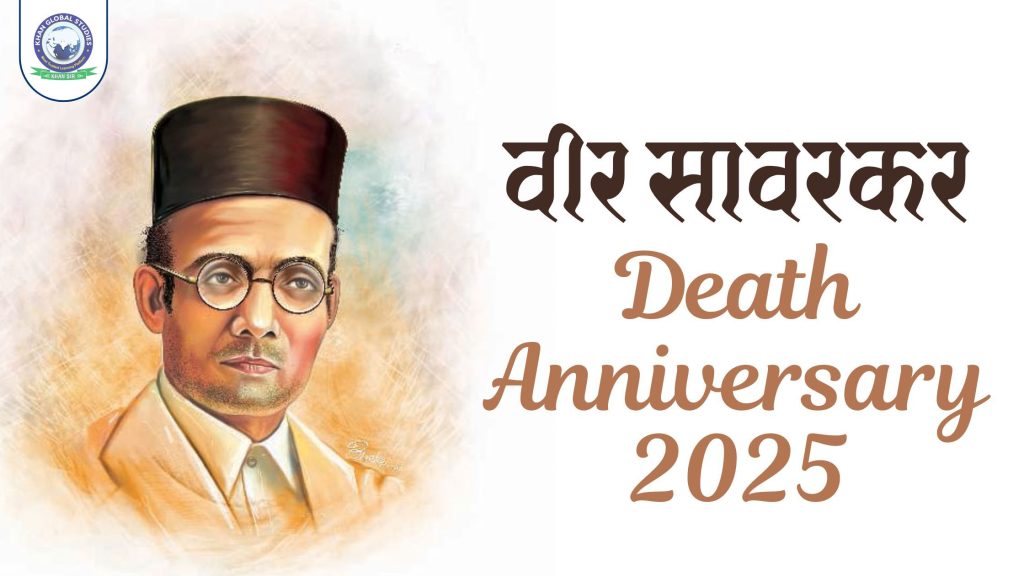Who was Veer Savarkar?
Veer Savarkar, whose full name was Vinayak Damodar Savarkar, was a great freedom fighter, writer, social reformer, and revolutionary. He was known for his revolutionary ideas and the ideology of Hindutva. He was one of the prominent warriors of the Indian freedom struggle and is regarded as a key proponent of Hindutva ideology. His followers honored him with the title “Veer” Savarkar, which means “brave.”
Birth and Early Life
Veer Savarkar was born on May 28, 1883, in Bhagur village of Nashik district, Maharashtra, into a Chitpavan Brahmin family. His parents were Damodar Savarkar and Radhabai Savarkar. He had three siblings—Ganesh, Narayan, and Mainabai. From childhood, he was highly intelligent and deeply patriotic. He received his education from Fergusson College in Pune and later moved to London to study law.
From a young age, he was inspired by revolutionary ideas. At the age of 12, during Hindu-Muslim riots in his village, he attacked a mosque and later admitted that he had “completely damaged the mosque.”
Revolutionary Activities and Stay in London
In 1903, Savarkar and his elder brother Ganesh Savarkar founded a secret revolutionary organization called Mitra Mela, which was renamed Abhinav Bharat Society in 1906. The main objective of this organization was to end British rule and restore Hindu pride.
In 1906, he went to London on a Shivaji Scholarship to study law. There, he joined India House and the Free India Society, advocating for complete independence for India.
Contribution to the Freedom Struggle
Veer Savarkar fought against British rule and participated in revolutionary activities to liberate India. He was associated with the “Abhinav Bharat Society” and inspired youth to join the freedom struggle.
Savarkar raised his voice against British rule and fought for India’s independence. He wrote the book The First War of Indian Independence, 1857, in which he described the 1857 uprising as India’s first war of independence. The British government banned this book because it had the power to inspire Indians to revolt.
Arrest and Cellular Jail (Kala Pani Sentence)
In 1910, the British government arrested him on charges of revolutionary activities and sent him to India on the SS Morea ship. When the ship stopped at the port of Marseille (France), Savarkar attempted to escape and sought political asylum, but French authorities handed him over to British police.
He was brought back to India and sentenced to 50 years of rigorous imprisonment in the Nashik Conspiracy Case. He was sent to the Cellular Jail in the Andaman and Nicobar Islands (Kala Pani), where he endured inhumane torture for 10 years.
Release and Political Activities
In 1924, after repeatedly submitting mercy petitions, the British government released him but restricted him to Ratnagiri district. After his release from jail, he promoted the Hindutva ideology and joined the Hindu Mahasabha.
When his confinement ended in 1937, he began promoting Hindu nationalism and Hindu unity across the country. At the Ahmedabad session, he supported the “Two-Nation Theory.”
World War II and Quit India Movement
In 1939, when the Congress resigned in protest against British rule, the Hindu Mahasabha, along with the Muslim League and other non-Congress parties, formed a government. When Mahatma Gandhi launched the Quit India Movement, Savarkar opposed it and encouraged Indian soldiers to join the British army.
Ideology of Hindutva
Veer Savarkar defined the concept of “Hindutva” and emphasized organizing Hindu society. His book Hindutva: Who is a Hindu? is considered a significant work on Hindu nationalism. He was actively involved in Indian politics through the Hindu Mahasabha.
Contribution to Social Reforms
Veer Savarkar made several contributions to social reforms, including:
- Opposing untouchability (caste-based discrimination)
- Advocating for women’s rights
- Efforts to reform the caste system
Death of Veer Savarkar
On November 8, 1963, his wife Yamunabai Savarkar passed away. After this, he renounced food and water on February 1, 1966, in what he called “Prayopavesa” (voluntary fasting to death).
On February 26, 1966, he took his last breath in Mumbai. In his final wish, he requested that no religious rituals be performed after his death. His son Vishwas Savarkar performed his last rites at the Sonapur Crematorium in Mumbai.
Legacy of Veer Savarkar
Even today, Veer Savarkar’s ideology and contributions continue to inspire us. He is remembered as a great revolutionary, social reformer, and thinker. His thoughts and sacrifices will always be a source of inspiration for the youth of India.




